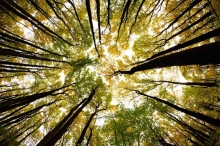You are here
Recent News
Ecologists have long predicted that climate change will send plants and animals uphill and towards the poles in search of familiar temperatures. Such movements have increasingly been documented around the...Read more
Biology had another fantastic year of graduate student research displayed at the 2017 Graduate Student Symposium!
Many thanks to graduate students Megan Whitney and Alex Brannick who organized the...Read more
Caroline Strömberg has been selected as the recipient for this year’s Schuchert Award from the Paleontological Society. The Charles Schuchert Award is presented to a person early...Read more
Prof. Ken Sebens and recent Biology PhD graduate Mike Nishizaki published with their collaborators on the "Energetics, Patricle Capture, and Growth Dynamics of Benthic Suspension Feeders".
Abstract
Marine benthic communities...Read more
Big congratulations to two Biology faculty members who won 2017 UW Innovation Awards! For more than 150 years, the University of Washington has been a place where the imagination thrives....Read more
Assc. Professor of Biology and Adjunct Curator of Vertebrate Paleontology, Greg Wilson, and his collaborators received the 2017 Bergstrom Award from the College of Arts & Sciences for their proposal "Prehistoric Body Theater"!...Read more
Each year, the Husky 100 recognizes 100 UW undergraduate and graduate students from Bothell, Seattle and Tacoma in all areas of study who are making the most of their time...Read more
Graduate student from the Riffell Lab, Eleanor Lutz, was recently named a winner in the 2017 "Vizzies", a scientific visualization challenge sponsored by the National Science Foundation (NSF) and Popular...Read more
The Parichy Lab was recently awarded a prestigious, 5-year $2.6M R35 grant from the National Institute of Health (NIH). This new grant, "Developmental origins and homeostatic mechanisms underlying adult phenotypes",...Read more
Galápagos penguin chicks have it good. Even when they are old enough to hunt on their own, they beg their parents for food — and the parents give in.
Recently...Read more










